SIP Walls and Roofs
Would you use SIPs for a Flat Roof
Believe it or not no!
Let’s be clear though – we are not stating that SIP panels cannot be used in this application and many panel manufacturers have worked hard to have this covered in their BBA certifications however we do not believe this to be the best way forward for our clients.
A SIP flat roof sounds advantageous as it can get you weather tight quickly however if we look at the overall build process for our clients it also has a number of disadvantages. Obviously there are always occasions when the SIP flat roof works perfectly well and is the correct solution (very small areas).
When you apply SIP panels into a low pitch or flat roof application, they lose a lot of their spanning potential. A span is the distance a SIP panel can be unsupported.
As the span capability decreases the need for additional support such as steels or glulam beams increases which obviously then increases cost and can inhibit architectural and aesthetic freedom. The heavier the roof, the more support required.
To avoid this some providers will cut down the width of the SIP panel and introduce more timber joints to make them span further but then you are removing lots of insulation from the build-up. This increases the issue of thermal bridging, so your U Value calculations (thermal performance) are extremely poor and or worse inaccurate as the increased timber has not been accounted for. You have paid for a performance you do not have at this point!
A SIP flat roof must also be a ventilated build up and it requires a vapour control layer (VCL) to the underside internally. If you apply a waterproofing finish to flat roof without ventilating it first (battens and roofing ply) you are going to have serious problems further down the line with the roof failing due to continuous condensation and moisture building up within the roof over time. Your warranty provider will also most likely not cover this as it is not an approved detail.
You also have no service zone to run any M&E or recess lighting into if required so a service void must be created which impacts internal head space.
Our preference
For flat roof applications we prefer a metal open web joisted deck. They span further, removing the requirement for additional structure, provide a service zone through the joists for follow on trades and are commercially more viable.
When your follow on trade arrives to insulate and weatherproof the roof, they are also then working with a standard joisted deck which they see every day and this joisted deck can be part of their warrantied roofing system on completion!
Do SIPs work with Oak Frames
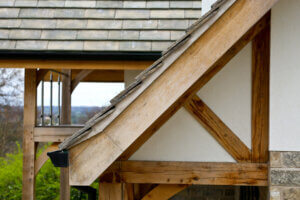 Structural Insulated Panels (SIPs) can be used for wrapping the external of an oak frame. This combination merges the traditional aesthetics and strength of oak framing with the energy efficiency and speed of SIPs construction.
Structural Insulated Panels (SIPs) can be used for wrapping the external of an oak frame. This combination merges the traditional aesthetics and strength of oak framing with the energy efficiency and speed of SIPs construction.
SIPs can be a great product when looking to achieve thermal performance whilst wrapping an Oak frame due to the low U values and fantastic air pressure tests that can be achieved.
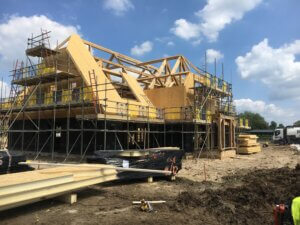 While oak frames provide the primary structural support, SIPs add to the building’s overall structural integrity. The panels can help to stabilise the frame and distribute loads of the external finishes.
While oak frames provide the primary structural support, SIPs add to the building’s overall structural integrity. The panels can help to stabilise the frame and distribute loads of the external finishes.
The challenges come from having a precision engineered, millimetre perfect SIP product that attaches to a natural Oak product that is notoriously difficult to keep straight and level due to the high degree of natural movement.
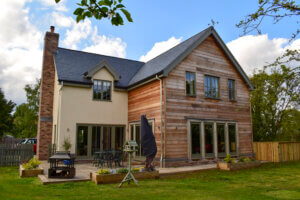 Experience in both design and installation are the keys to ensure that enough tolerance in the SIP has been allowed for due to the movement of the Oak. Standard SIP fixings must not come into contact with the wet oak (Green Oak) unless stainless steel SIP screws are being used. With the SIP being precision engineered the use soft wood batten and counter battens in the build up are a great way to remove any tolerance issues between both products.
Experience in both design and installation are the keys to ensure that enough tolerance in the SIP has been allowed for due to the movement of the Oak. Standard SIP fixings must not come into contact with the wet oak (Green Oak) unless stainless steel SIP screws are being used. With the SIP being precision engineered the use soft wood batten and counter battens in the build up are a great way to remove any tolerance issues between both products.
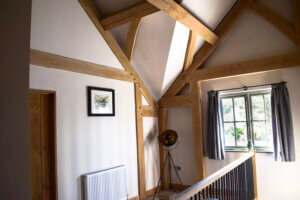 The use of SIPs with an oak frame still provide the visual appeal that oak frame homes are designed for while thermally enhancing a structurally sound wall build up that can have internal services and plasterboard fixed directly to it. The use of a 15mm OSB/3 SIP panel facing will ultimately give the greatest amount of pull-out strength from a panel and generally the need for specialist fixings at later stages is unlikely to be required. This is not always the case when thinner OSB/3 SIP panels are used.
The use of SIPs with an oak frame still provide the visual appeal that oak frame homes are designed for while thermally enhancing a structurally sound wall build up that can have internal services and plasterboard fixed directly to it. The use of a 15mm OSB/3 SIP panel facing will ultimately give the greatest amount of pull-out strength from a panel and generally the need for specialist fixings at later stages is unlikely to be required. This is not always the case when thinner OSB/3 SIP panels are used.
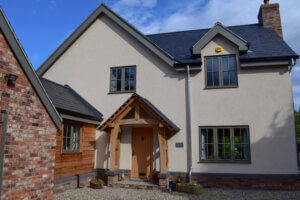 The oak frame can and generally is left exposed on the interior for a classic look, while the SIPs can be finished on the exterior using any finish that is required, be it brickwork, stonework, timber cladding, render or other rainscreen systems.
The oak frame can and generally is left exposed on the interior for a classic look, while the SIPs can be finished on the exterior using any finish that is required, be it brickwork, stonework, timber cladding, render or other rainscreen systems.
As with building a SIP’s home the speed of erecting SIPs to an oak frame is fast and efficient. By using SIPs on the external walls and Roof you end up with a weathertight building much quicker than traditional methods. A huge benefit to this is reduced exposure times for the oak to the elements. The quicker you are weather tight the sooner your follow-on trades can start!
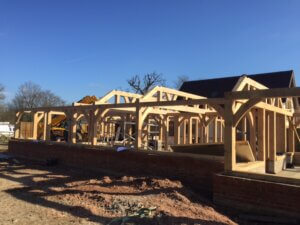 Green oak is generally considered a superior choice for practical reasons, especially when compared to kiln-dried timber. Kiln drying, particularly for timber sections thicker than 100mm, is not only economically challenging but can also be detrimental to the wood’s structural integrity. In the drying process, larger timber sections are prone to damage, potentially leading to warping and distortion once the timber is part of a structure. Additionally, kiln drying is less environmentally friendly due to its high energy consumption.
Green oak is generally considered a superior choice for practical reasons, especially when compared to kiln-dried timber. Kiln drying, particularly for timber sections thicker than 100mm, is not only economically challenging but can also be detrimental to the wood’s structural integrity. In the drying process, larger timber sections are prone to damage, potentially leading to warping and distortion once the timber is part of a structure. Additionally, kiln drying is less environmentally friendly due to its high energy consumption.
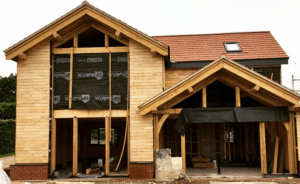 In contrast, the process of air-drying oak frame timbers is lengthy, often spanning six to eight years. However, the industry lacks a standardized method for categorizing moisture content, leading to situations where oak is marketed as air-dried despite only being surface dry, sometimes being only a few months to a couple of years old. While air drying avoids the risks associated with kiln drying, it introduces higher labour and storage costs, making the material more expensive. This process can also lead to inefficiencies and waste, as there’s no guarantee that timbers of the required size will be readily available.
In contrast, the process of air-drying oak frame timbers is lengthy, often spanning six to eight years. However, the industry lacks a standardized method for categorizing moisture content, leading to situations where oak is marketed as air-dried despite only being surface dry, sometimes being only a few months to a couple of years old. While air drying avoids the risks associated with kiln drying, it introduces higher labour and storage costs, making the material more expensive. This process can also lead to inefficiencies and waste, as there’s no guarantee that timbers of the required size will be readily available.
From a craftsmanship perspective, green oak is preferable to seasoned oak for cutting and shaping. Its properties make it more amenable to fine workmanship, resulting in higher quality outcomes in construction and design.
Are you using a CNC manufactured Oak frame or is it hand cut?
This question is important for two reasons. Firstly, they have a different look one more rustic than the other. Secondly the precision engineered frame will likely have less variations and lead to less tolerance issues on site. A precision engineered frame may also provide less tolerances on site which means that the following install of the SIPs can be more accurate without the requirement for remedial works on site.
Hand cut or CNC – the quality of your onsite labour is the key so ensure you see examples of previous work!!
Oxted Residential Development
A bespoke (SIP Cladding to an Oak Frame) home built for performance and style in Oxted.
👉 View the Case Study ›

